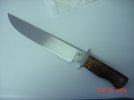- Joined
- May 12, 2003
- Messages
- 1,606
Tony, I used the example of the Grohman knife to illustrate a design meant for a specific practical use, which is after all the topic of this thread. The fact that it does not have a guard is a major design flaw. Goes to show that most knives can be improved upon.
That is why so many of makers continue to push the idea of high performance.A high performance knife does not mena just good steel. It is an entire package of features. Each component part must be examined and refined. This includes the sheath. Unfortunately the changes are generally so subtle that most customers don't recognize the difference.(I.E.The modified Micheal Price Grind) If you have not used a knife in tough condition you may not appreaciate the subtle improvement that grind makes. And unless you know what to look for, you might miss it all together. By the the way, for all the makers who wonder, it is not an easy grind.
So much of what we do is education. Before we can help the public understand what elements in a blade are useful we have to test the rightness of our own understanding of the knife as a tool.
I would suggest we all take a look at the "working" knives we produce and ask why we are making them the way we are. Is it just because it looks neat? Or is it becasue that's the way we have always done it? Or was that how we were taught? If at any time during your study you come up with an "I don't know." Then there is probably an opportunity to simplify some part of what you are doing. The maker who revises his ideas constantly then puts his ideas to the test will eventually perfect the function of his blades. AS a proviso, the most important thing a maker can do is to understand completely the work his knife will do. If you are designing a knife to fight with then you will have some different ideas about design than the amn who is designing a knife to fillet a big gar.
I appreciate all of the knives I have seen on this thread. Some day I hope I can do such beautiful work. But right now I am just centering around the design elements that are practical for use in my specific part of the world.
Again I would ask for some specific testing or stories about other makers design and their specific uses. Maybe we can compare notes and discover something new.
Take Care!
shane
That is why so many of makers continue to push the idea of high performance.A high performance knife does not mena just good steel. It is an entire package of features. Each component part must be examined and refined. This includes the sheath. Unfortunately the changes are generally so subtle that most customers don't recognize the difference.(I.E.The modified Micheal Price Grind) If you have not used a knife in tough condition you may not appreaciate the subtle improvement that grind makes. And unless you know what to look for, you might miss it all together. By the the way, for all the makers who wonder, it is not an easy grind.
So much of what we do is education. Before we can help the public understand what elements in a blade are useful we have to test the rightness of our own understanding of the knife as a tool.
I would suggest we all take a look at the "working" knives we produce and ask why we are making them the way we are. Is it just because it looks neat? Or is it becasue that's the way we have always done it? Or was that how we were taught? If at any time during your study you come up with an "I don't know." Then there is probably an opportunity to simplify some part of what you are doing. The maker who revises his ideas constantly then puts his ideas to the test will eventually perfect the function of his blades. AS a proviso, the most important thing a maker can do is to understand completely the work his knife will do. If you are designing a knife to fight with then you will have some different ideas about design than the amn who is designing a knife to fillet a big gar.
I appreciate all of the knives I have seen on this thread. Some day I hope I can do such beautiful work. But right now I am just centering around the design elements that are practical for use in my specific part of the world.
Again I would ask for some specific testing or stories about other makers design and their specific uses. Maybe we can compare notes and discover something new.
Take Care!
shane

